Chernobyl: Unseen
- Andrew Hocking
- Aug 31, 2020
- 8 min read

A few months ago, while I was stuck at home under Covid-19 lockdown, my Chernobyl Exclusion Zone trip from May 2019 popped up on my Facebook memories. With plenty of time on my hands, and having recently learned new editing techniques, I explored these forgotten photos on my hard drive...
Why wait until now?
A SLAVE TO MY BRIEF...
Originally, I set out on the trip with a self-set brief - titled "Reclamation." Although masses of people haven't yet visited like other sight-seeing destinations, I felt that there were many photographs out there of the same sights. So, as our visit was in springtime, I decided to seek out photographs showing how nature is reclaiming the the zone. Having edited and shared these photos, the rest were put aside (until now!). Read my "Chernobyl: Reclamation" blog - to see the original set of photos and an account of my experience during the trip.
NEW TECHNIQUES UNLOCKED NEW IMAGES...
Another reason why these photos had languished on my hard drive for a year, was that I just hadn't seen the potential in the unprocessed JPEG files.
During lockdown though, I found the time to learn more about image processing in Lightroom. This of course, happened in spring, so I had just learned techniques for processing spring woodland images from my lockdown shoots (as part of my daily walk). These techniques transferred across to my Chernobyl photos perfectly - adding mood and doing away with garish spring colours that can easily creep in during the editing process.
Technical stuff...
On top of my usual edits, here's a summary of my new spring scene Lightroom editing techniques used to bring the photos to life:

CURVE: I learned that placing a node at around the third point, a second node to the right of the first to restrain the curve, and then dragging the line up from the left gave me a subtle low contrast style. Not the high contrast look that was previously quite typical of my work. I've continued this technique into much of my recent work.

COLOUR MIXER (HUE): In addition to Saturation and Luminance edits in the Colour Mixer, I found that dragging the "Greens" slider a little to the right gave just the green hues in the image a slightly bluer tint. For me, this is preferable to the garish yellow and vibrant greens seen in some of my springtime photos in the past. For the Chernobyl series of images, it better portrays the sombreness of the subject.

SPLIT TONING: You'll notice that many Hollywood films and gritty TV dramas use "colour grading" to add impact to their visuals. The most obvious style to look out for is the use blue & orange - often in action films. These contrasting colours at opposite ends of the colour wheel combine to add punch!
In Lightroom, there's "Split Toning" to colour grade our images. The colour wheel has 360 increments of colour. So, opposing colours are 180 increments apart. Shown here is a screen shot from one of my Chernobyl photo edits. Here, I picked out some of the orange (50) highlights in the fallen leaves and the red stripe of our bus, and contrasted it by picking out the bluer (230) shadows in the spring leaves. *A little trick is to hold the Alt key while dragging the Hue sliders to see how the image will be affected.
ORTON EFFECT: I use this technique very subtly to add a soft glow to an image. It's a little trickier to describe. So, I'll let Thomas Heaton explain!...
The unseen photos...

CHERNOBYL POWER PLANT
A shot snapped of the Chernobyl Power Plant - taken from the roadside over a drained waterway which I assume was once used as part of the cooling system.
© Andrew Hocking 2019

SMOKESCREEN
smokescreen: noun - a cloud of smoke created to conceal military operations. - a ruse designed to disguise someone's real intentions or activities.
I thought that title was quite apt! Here a truck, believed to be KAMAZ-53213 (an educated guess by my self-confessed "transport nerd" mate), bellows out smoke as it roars up the road. At the time, I was doing a bit of crane lorry (with brick grab) driving to cover absent colleagues - so, while all the "bus veges" in our group were drooling over the LAZ buses, photographing this KAMAZ with crane was as close as I got to nerding out! To the right of frame, you can see the Chernobyl Nuclear Power Station - colour coordinated with the truck! The people milling about were probably workers who still man the power plant.
© Andrew Hocking 2019

DESPAIR
Graffiti inside the Chernobyl Exclusion Zone is generally frowned upon. Most visitors want to see the ghost town of Pripyat and surrounding abandoned villages as they were left - changed only by nature over time. This artwork inside the unfinished Reactor 5 cooling tower is somewhat of an exception. Before we entered the tower, our guide prepared us for "the best graffiti artwork in the zone." He was probably right! The mural of a doctor was painted by Australian artist, Guido van Helten, to mark the 30th anniversary of the world's worst nuclear disaster. Helten worked from a photo taken by world renowned photojournalist, Igor Kostin - taken shortly after the disaster in 1986.
© Andrew Hocking 2019
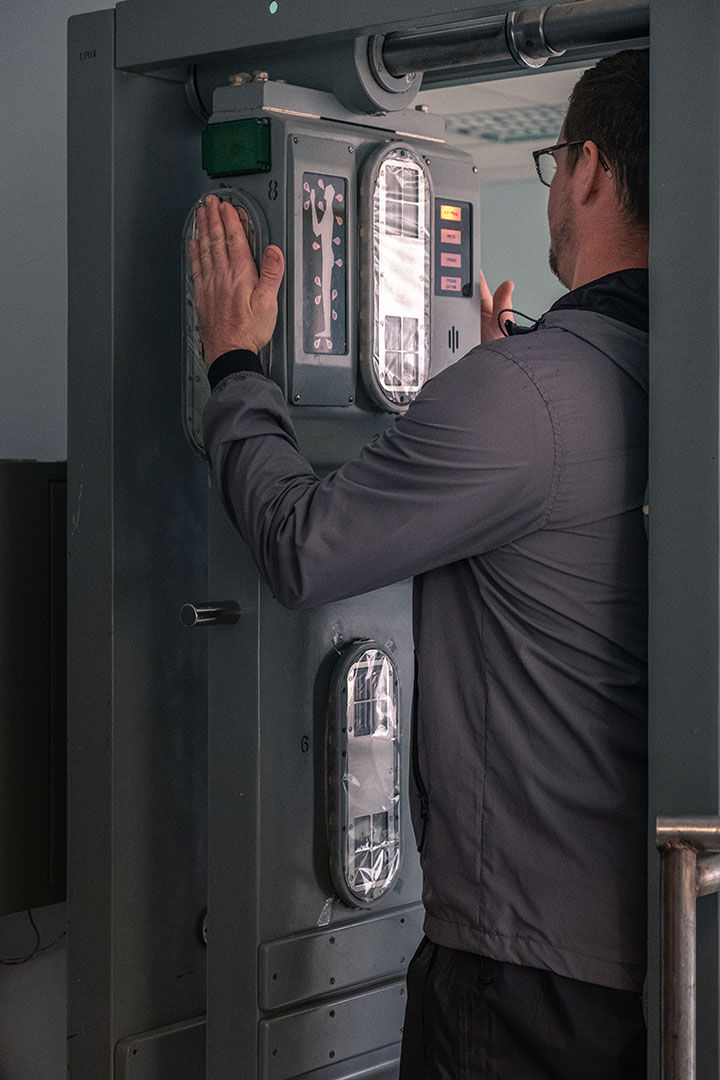
RADIATION CHECK
My friend, Joe, testing for radiation before entering Chernobyl Nuclear Power Plant's canteen. We all had to pass through this machine at the entrance to the canteen block every day. Thankfully it never flashed and buzzed for any of us!
© Andrew Hocking 2019

ON THE SCROUNGE
One of the dogs milling about outside the Chernobyl Power Plant Canteen - where we ate lunch for three days. I guess these dogs are descendants of domestic animals left behind after the evacuation. They were pretty friendly - no doubt surviving off treats from workers and visitors to the plant.
© Andrew Hocking 2019

KEEP A LID ON IT
Our Russian LAZ tour bus (with our driver, Vadim, in shot to the left), parked out side the Chernobyl Nuclear Power Station. This massive dome was built to contain radiation from the melt down of reactor 4 in 1986. The structure also encloses the temporary Shelter Structure (sarcophagus) that was built around the reactor immediately after the disaster. It was completed in July 2019, stands 108m tall, spans 260m, and cost 2.1 Billion Euros.
© Andrew Hocking 2019
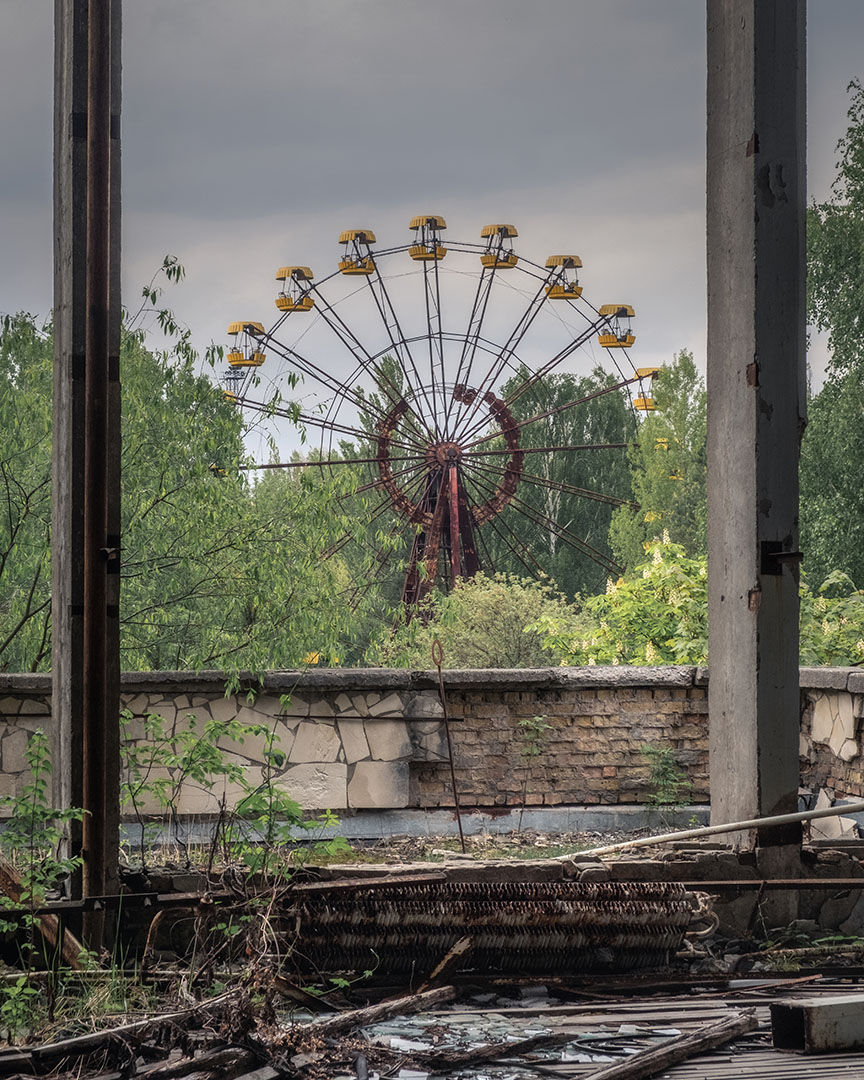
MISFORTUNE
Prypiat's iconic abandoned ferris wheel - as featured in the game, "Call of Duty 4." This was shot from a nearby abandoned building, through the trees that have sprung up all over the city.
© Andrew Hocking 2019

DODGEY II
© Andrew Hocking 2019

DODGEY III
The abandoned dodgems at the iconic amusement park in the town of Prypiat, near the Chernobyl power plant. It was due to have its grand opening on 1st May 1986, in time for the May Day celebrations. These plans were cancelled on 26 April 1986, when the Chernobyl disaster occurred a few kilometres away. © Andrew Hocking 2019

UNREGISTERED
An old cash register / till in one of Pripyat's abandoned supermarkets. Pripyat is situated a few kilometres from the Chernobyl Nuclear Power Station which melted down on 26th April 1986. The town was evacuated the next day, leaving it an uninhabited ghost town.
© Andrew Hocking 2019

LADA
© Andrew Hocking 2019

ONE CAREFUL OWNER
After we passed the first military checkpoint, we were to stay inside the exclusion zone until we had finished our 3 tour. Our first stop just inside the zone, was an abandoned village called Zalissia. Abandoned even though it's slightly further from the blast (almost 30km) than the town of Chernobyl which is still home to a few hundred people - and where we stayed. Zalissia was very over-grown. Main roads are now no more than footpaths and trees obscure buildings. Several cars can have been abandoned there - stripped for parts, presumably by looters. Here's an old Lada - once a favourite in eastern Europe. In fact we saw a few pootling around the city of Kiev where we spent a couple of days after leaving the exclusion zone
© Andrew Hocking 2019

TRAINWRECK
Yaniv Station in the Chernobyl Exclusion Zone was a graveyard for old trains. While wandering the rusting wrecks, I had a pretty scary moment! A dog came rushing up to me, lips curled, showing it's teeth and snarling. It stopped just a couple metres from me! I walked away slowly and thankfully it left me alone. I'm not sure if it was a wild dog descended from abandoned domestic pets, or a guard dog.
© Andrew Hocking 2019
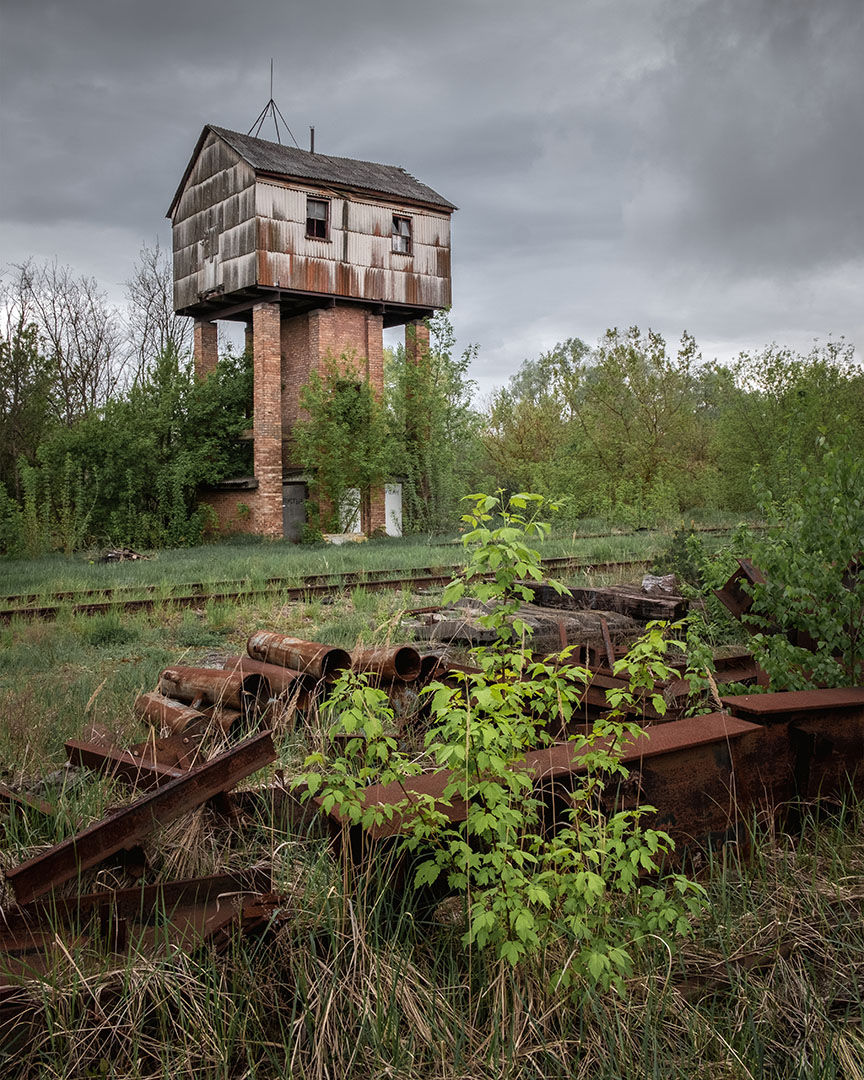
LOST SIGNAL II
(Re-edit with new techniques)
I initially wasn't bothered about processing this shot as the light was pretty flat and uninspiring. I liked the subject though - an abandoned railway signal tower at Yaniv Station. So I decided to do a few quick edits... which turned into a hour or so! But I've ended up with an image that I'm happy with. Shooting in RAW and holding a grad filter in front of the lens (as my filter holder didn't fit the borrowed camera) allowed me to retain detail in the grey sky - brought out in Lightroom & Photoshop. To some extent, this image demonstrates how nature is reclaiming the Chernobyl Exclusion Zone - which was my personal project.
© Andrew Hocking 2019

MAZ 504
A 1970's MAZ-504 truck near the abandoned Yaniv Train Station.
© Andrew Hocking 2019

ROAD TO DUGA
On the way out of DUGA Radar Station, we jumped out of our old LAZ bus to photograph the classic Ukrainian vehicle with the radar structure behind it. The massive, 150m high x 550m long radar near Pripyat was erected to detect incoming missiles. Our guide provided some interesting detail as to how the location was kept secret from the world - including Russian civilians. The military site is accessed via a 6 mile long road (pictured) through dense forest. The road was intentionally built with slight turns so that the base could not be seen from a distance. More interesting still, is that old Soviet maps labelled the base as a children's summer camp - and a bogus bus stop complete with a mosaic children's illustration was constructed at the beginning of the access road to support the ruse.
© Andrew Hocking 2019

DUGA ROOF GARDEN
Taken from a high roof-top at the abandoned DUGA Radar military base. I like how there's some good sized trees now growing from the roof of the base. I wonder how long the roots will support them. To the left of the frame is the massive radar - sometimes referred to as "The Woodpecker" on account of the sound it made while in operation. As with almost all of the zone, it's completely abandoned - although we did meet the locally famous "Tarzan" - a wild, but friendly dog that roams the zone!
© Andrew Hocking 2019
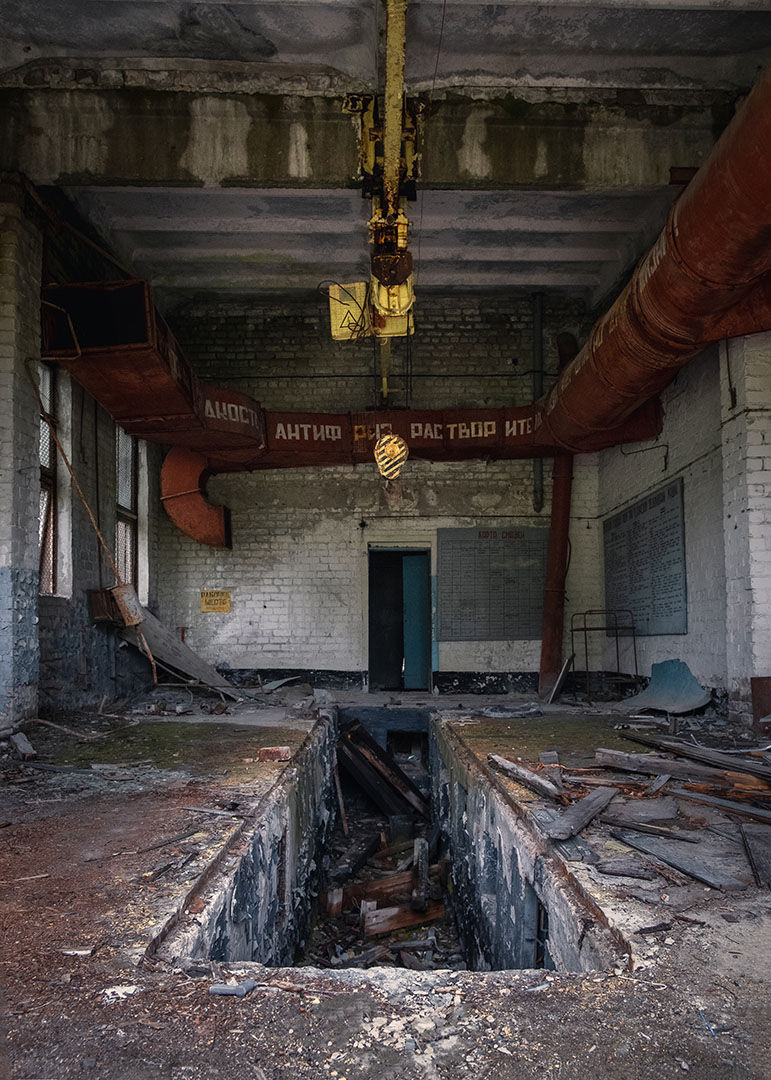
DUGA GARAGE
An abandoned motor workshop, complete with inspection pit and gantry crane, at the DUGA Radar military base - inside the Chernobyl Exclusion Zone.
© Andrew Hocking 2019

EXIT THE MATRIX
Here's our 1970's Ukrainian LAZ bus, booked specifically by "GAMMA Travel" to cater for the self confessed "bus nerds" (or "veges") in our group. While parked in this square, just after we all got out, one of the rear tires blew out! The bang echoed around around the square like a gunshot. At first, our tour guide, Nikolai, thought it was "Chernobyl Stalkers" playing a joke on us. We were told that the Stalkers enter the zone illegally to explore and graffiti. The punishment for entering this military exclusion zone illegally? - Being escorted back to the outer checkpoint, put in a taxi back to Kyiv, and fined something in the region of £10! Apparently the fines and punishment were due to be massively increased.
© Andrew Hocking 2019
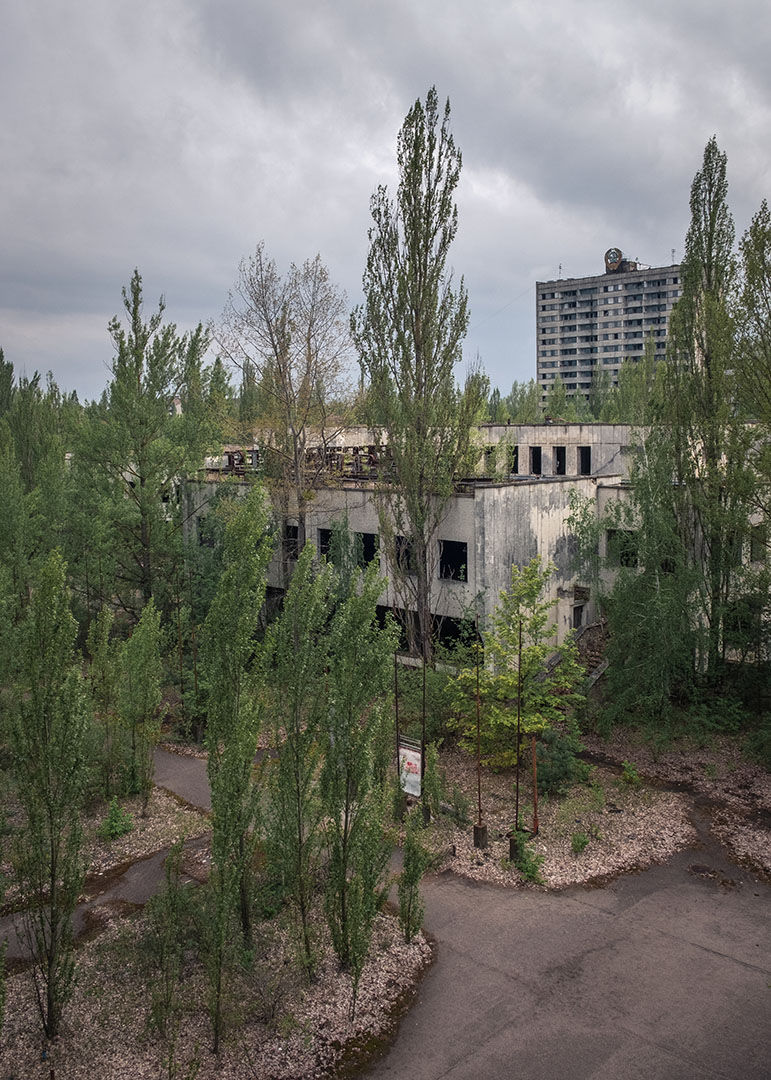
PRIPYAT GHOST TOWN
The ghost town of Pripayt - evacuated the day after the Chernobyl Nuclear Power Plant meltdown on 26-04-1986. I don't remember the particulars about this photo, but I'm guessing I took it from a tall(ish) building. In the distance is the "Vokshod" apartment block - one of the tallest in the city. I've read that it housed the elite engineers.
© Andrew Hocking 2019

LAST STOP
A lot of my travel companions on last year's trip inside the Chernobyl exclusion zone were self confessed bus nerds... So, they loved this part of our trip when we visited the abandoned bus terminal at Pripyat. I remember our group organiser was really keen to get our 1970's Ukrainian LAZ bus parked at the bus stop outside the ticket office. So much so that he cleared a path - by moving some fallen branches. It did make for a great picture though. And probably the first time a bus has pulled up at that stop in decades!
© Andrew Hocking 2019
LINKS...
With the emergence of all these new photos, a selection of my best images can now be seen in my new "Chernobyl Gallery."
Read my "Chernobyl: Reclamation" blog - for my original set of photos and an account of my experience during the trip.
Did you like this? Go on... give it a share!...
#chernobyl #pripyat #urbex #ghosttown #ukraine #landscapephotography #landscape #flatlight #grey #overcast #HBO #Yaniv #Station #Duga #Adventure #holiday #FujiXT2 #exclusionzone #fuji #mirrorless #mirrorless #MAZ #LAZ #AndrewHocking #dodgems #fairground #funfair #woodpecker #radar #duga #darktourism





Comments